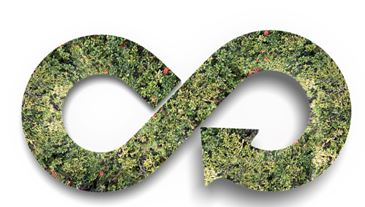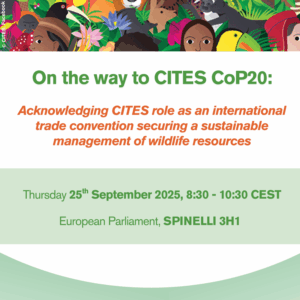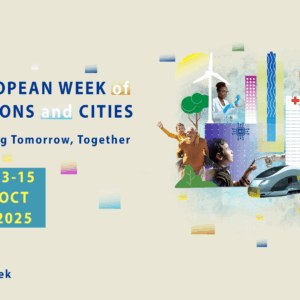
The Role of Bioeconomy in the Circular Economy – Taking circularity beyond waste
12 January 2017, 12:00-14:00
Members’ Salon, European Parliament, Brussels
Co-Chaired by Miapetra Kumpula-Natri MEP
Chair of the “Bioeconomy” Working Group of the EP Intergroup on “Climate Change, Biodiversity, and Sustainable Development”
Miriam Dalli MEP
Chair of the “Circular Economy” Working Group of the EP Intergroup on “Climate Change, Biodiversity, and Sustainable Development”
Policy-makers, industry representatives and stakeholders active in the field of bioeconomy gathered in the European Parliament to discuss the pivotal role of the bioeconomy in the circular economy and how to better harness its potential within the EU Circular Economy Strategy and in Europe.
Miapetra Kumpula-Natri MEP and Chair of the “Bioeconomy” working group of the EP Intergroup on “Climate Change, Biodiversity, and Sustainable Development” welcomed the participants by underlining the importance of supporting a bioeconomy and the need to enable a coherent framework and promote the necessary steps. It was said that different approaches are available as it is necessary to adapt to the various circumstances found in each Member State.
Miriam Dalli MEP and Chair of the “Circular Economy” working group of the EP Intergroup on “Climate Change, Biodiversity, and Sustainable Development” opened the meeting by further reiterating the diversity of Member States underlining the complexity of bringing all elements together on the policy side. The importance of the Blue Growth Strategy was stressed showcasing that there are various opportunities for the bioeconomy in Europe and that customising the different bioeconomies (e.g. forest, marine, agriculture) can benefit all Member States. It was said that the work on the circular economy in the Parliament continues and that the current Maltese Council Presidency has also assured that it is one of its priorities.
The European Bioeconomy Alliance (EUBA), which is a cross sectoral alliance that aims to mainstream and realise the potential of the bioeconomy in Europe, highlighted that bio-based feedstocks and materials can be used to produce a wide range of products. As such, the bioeconomy is already a part of our daily lives, as we use various bio-based products, e.g. clothes, cosmetics, packaging, toys etc., and sometimes without realising that they are made from renewable resources. It was emphasised that the EUBA aims to lead the transition towards a post-petroleum society while decoupling economic growth from resource depletion and environmental impact. Part of its mission is also to support the development of the bioeconomy in Europe, provided that a policy framework to ensure a fair, predictable and coherent basis for business to operate is guaranteed. The importance of biorefineries, where biomass from a range of sources such as crops, wood, forest and agricultural residues is converted into everyday products and materials, was further emphasised as they are critical to optimising resource use and food security. The bioeconomy is already a reality, with a yearly turnover of 2.1 trillion euro also providing 18.3 million jobs in Europe. It was underlined that the bioeconomy is the biological motor of the circular economy as it brings the renewability aspect into the cycle, puts carbon ‘back in the loop’, and brings additional dimensions to the circular economy discussion, moving beyond waste. It was stressed that in order to fully reap the benefits of the circular economy the bioeconomy must be part of the discussion and thoroughly considered. The role of the bioeconomy in other EU policy objectives and policies, such as jobs and growth, climate and energy and R&I was also referred to. In this context, it was stressed that the bioeconomy and bio-based industries along the value chain need a coherent, holistic and supportive policy framework, across the various policy areas. The importance of innovation and technological development was stressed as well as the need to increase public funding and re-risk investments. The Circular Economy Action Plan acknowledges that the bioeconomy can contribute to the circular economy, and the EUBA is calling for an ambitious implementation giving the bioeconomy a central position. Further, the need to emphasise links and synergies in the Circular Economy Package, and beyond, was also raised. With regards to the waste legislative proposals which are currently being revised, it was said that the focus should be further extended beyond waste management, for example by incentivising the use of bio-based materials and products in the Packaging and Packaging Waste Directive. The need to clearly define concepts such as bio-based and biomass is also essential, and in this regard reference was made to the standard on general terminology applicable to bio-based products developed within CEN. The EU Bioeconomy Strategy is currently under review and need to ensure continued emphasis on the bioeconomy was raised, with the EUBA calling for a revision of the Strategy. In this context, the need to integrate the bioeconomy across policy areas and ensure coherence and ownership across DGs was stressed as well as the need to continue with Public-Private Partnerships, amongst other things. The presentation was concluded by encouraging policy makers and stakeholders to advocate for a clear role for the bioeconomy in ongoing and upcoming positions and legislation.
Erik Mathijs, Professor of Agricultural and Resource Economics, Department of Earth and Environmental Sciences, University of Leuven outlined the main findings of the report “Sustainable Agriculture, Forestry and Fisheries in the Bioeconomy – A Challenge for Europe”[1], which was produced under the Standing Committee on Agricultural Research (SCAR) Expert Group. It was said that the report helps explain some of the barriers when trying to implement the bioeconomy. It was underlined that the bioeconomy is a dynamic concept providing goods and services, emission of pollutions, negative and positive externalities, and helps keep in order biosphere capacities and functionalities viable and sustainable. It was outlined that the bioeconomy is based on two premises. Firstly, biomass is underexploited. It was said that too many fractions are not used optimally and more material and energy can be extracted from current biomass streams. Secondly, the biomass potential can be upgraded by closing yield gaps, introducing new or improved species, introduce new and improved extraction and processing technologies. It was outlined that an efficient and sustainable bioeconomy is based on the principle of fractionation. This implies that the nutritional needs of animals and humans are not fulfilled by only one crop but that a combination of fractions of plants and animals is always necessary. It was stressed that fractionation increases resilience of the food system, which is something that should be stimulated rather than slowed down. Further, because of specialisation fractionation is now done throughout the value chain. In this sense the example of sugar beet was raised highlighting how it is utilised to produce a range of products. The example of soy was also presented, which shows that it can be difficult to define the main incentive behind its utilisation as soy produces both oil and meal. It was stressed that what is considered the by-product and the main product depends on the economic conditions and vary from each country. The importance of small scale refineries was further stressed and that more farmers need to gain an interest in this concept, particularly in the southern and eastern parts of Europe. It was however underlined that not all is recycled and reused. The main challenges of agriculture relate mainly to nitrogen and phosphorous. The global nitrogen flow based on our food production was presented mentioning that there are three options to minimizing it; resource efficiency; closing the system; re-designing the system. It was said that there is most often a positive perception surrounding the bioeconomy but that issues concerning the fuel versus food debate are often highlighted as concerns. It was stressed that the bioeconomy can help address various societal challenges also pointing out its great potential in the eastern part of Europe. It was reiterated that a lot is bio-based already showcasing that biomass is variously used in different sectors. Five key principles for a sustainable bioeconomy were raised; feed first; sustainable yields; cascading approach; circularity; diversity. It was said that they may be difficult to translate into policy as many policy frameworks exist with conflicting interest. The need for coherence and integration was reiterated. Four issues were raised that will impact the implementation of the bioeconomy. Firstly, bioeconomy governance was stated as critical. Research should help develop a framework aimed at fostering the bioeconomy mentioning policies that are coherent, create a level playing field, avoid overexploitation and foster a diversity of practices. The second issue is business models as circularity requires new ways of designing and manufacturing products, new relationships between economic actors, and new ways of recycling components and waste. Further it was said that actors and activities will be reassembled in time and space also mentioning that public goods are part of the new production and could involve the public sector. The third issue relates to the socio-cultural dimensions stressing that knowledge on impacts and mechanisms of social change should co-evolve with technology stressing also full stakeholder involvement. Science may change food production and consumption patterns, which may break established routines and create resistance, which need to be better understood. Approaches have legal implications that need to be addressed by research. The final problem involves the need to push circularity down to the consumer level, which is where the largest share of waste is found with no end-of-life valorisation of food. This was stated as one of the biggest challenges of the bioeconomy.
The discussion with the audience further reiterated that the potential for biomass is underexploited stressing the important role that forest play and the materials that they can provide. The debate on food versus fuel was mentioned asking whether there is any scientific consensus on whether there is a real zero sum game between agriculture for food and agriculture for fuel. It was said that no consensus exists because of the complexity of the mechanisms involved. It was said that it has been observed since 2008 that food prices and oil prices are correlated to a greater extent than before. It was explained that when crops are used for fuel the demand for crops increases along with the prices. The impact this has on food security depends on the country and even on regions within countries. The possibility of insects as a new source of food was raised. It was said that there are projects within Horizon 2020 on novel proteins but that insect production in the EU is still too expensive and faces certain circularity issues as EU food safety laws limit the competitiveness. The discussion further highlighted other ongoing legislation in the Parliament which tackles the biomass debate such as the dossier on LULUCF (Land use, land use change and forestry). It was also called upon legislators to make use of the Circular Economy Action Plan and to take the opportunity to ensure that it goes beyond waste and incentivises the use of bio-based materials and products in packaging notably. The importance of environmental education was raised by MEP Franc Bogovič. The need to involve consumers was reiterated calling on the need to educate and ensure understanding from society. The need to work together with people also cautious about not moving too fast to avoid mistakes was also stressed. The discussion further highlighted the importance of also finding local solutions in order to adapt to the various circumstances in Europe. It was mentioned that technology and science may advance providing various options. The scenario was also imaged where there could be a break in energy production and the bio-based economy could be less needed than expected. It is difficult to have a clear direction defined but the co-evolution between society and technology is pivotal. The importance of showcasing bio-based products was stressed also mentioning that there are many different ways to do so referring to the recent Bioeconomy Conference, which was organised in 2016 under the Slovak Presidency [2].
The meeting was concluded by MEP Miriam Dalli who further stressed that the discussion addressing the use of bio-based products is not yet as active as it should be and that all stakeholders should push matters forward to find common ground that benefit the citizens. Various bio-based products were also showcased, and it was explained what they were made of, highlighting the possibilities of the bioeconomy. MEP Miapetra Kumpula-Natri further added that the European Parliament looks forward to the outcomes of the Bioeconomy Strategy review, which the Commission is currently working on. The differences of European countries when it comes to issues such as natural resources, feedstock availability and climate conditions were further reiterated also underlining the possibilities that they can bring when it comes to leveraging the full potential of the bioeconomy.
[1] https://ec.europa.eu/research/scar/pdf/ki-01-15-295-enn.pdf#view=fit&pagemode=none
[2] https://ebcd.webmaker.gr/wp-content/uploads/2017/01/Bio-based-Economy-made-in-Europe.pdf

